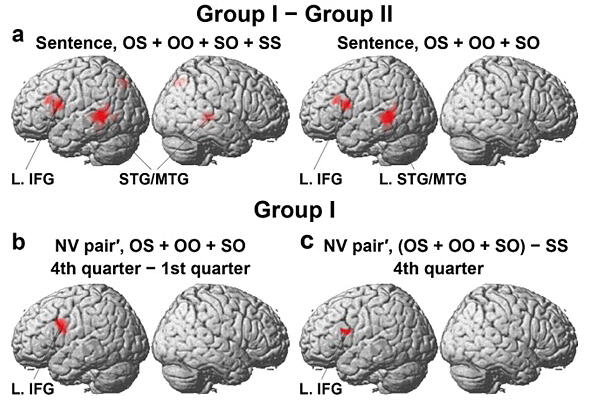A research group led by Professor Kuniyoshi Sakai and Assistant Professor Keita Umejima of the Graduate School of Arts and Sciences at the University of Tokyo, in collaboration with Professor Suzanne Flynn of the Department of Linguistics and Philosophy at the Massachusetts Institute of Technology, announced that they have identified the brain region that controls the acquisition of grammar when Japanese native speakers who have acquired English, Spanish, or other languages learn a new language auditorily. A functional magnetic resonance imaging (fMRI) machine was used to record brain activity during the participant's auditory-only acquisition of the Kazakh language. The "dorsal left inferior frontal gyrus," which is involved in the grammatical processing of native and second languages, was also found to play an important role in the acquisition of a third language. The research was made possible with the support of General Incorporated Foundations, the Institute for Language Experience, Experiment & Exchange (President: Kenshi Suzuki).
The results are expected to shed light on the brain mechanism underlying language learning, particularly efficient foreign language learning and were published in the international academic journal Scientific Reports.

Umejima, K., Flynn, S. & Sakai, K.L. 10.1038/s41598-023-50896-6. CC by 4.0
Japanese people learn English as a foreign language in compulsory education, but many can have issues with speaking. In contrast, in European countries bordering countries where other languages are spoken, as well as in multiethnic Asian countries, many people speak multiple languages on a daily basis. The neuroscientific mechanism for this multilingual adaptation has not been well understood.
Sakai and his colleagues have identified the "grammar center" of the brain involved in grammatical processing of native and second languages in their research to date. The brain activity also showed that a multilingual group with experience in acquiring three or more languages had an advantage over a bilingual group in acquiring new languages.
Based on behavioral experiments in language acquisition, Flynn proposed the "cumulative enhancement model for language acquisition," a hypothesis that the cumulative effect of multilingual acquisition allows for a deeper level of acquisition. The Institute for Language Experience, Experiment & Exchange (the LEX Institute) has also long practiced multilingual activities, where language acquisition is done by repeatedly listening to multilingual texts in a natural voice.
In this study, the research group used an fMRI machine to examine the brain processes of 31 participants (aged 14−26 years), all native Japanese speakers with experience acquiring English, Spanish, and other languages, who were asked to learn Kazakh, a language they had never been exposed to, auditorily alone while solving a grammar task with a high grammatical load. As a result of narrowing down the region based on the percentage of correct answers in various tests and the acquisition process, the brain region responsible for language acquisition was identified as the "dorsal left inferior frontal gyrus." It was also found that the higher the listening score, the faster the acquisition of a new language. The low English proficiency of the Japanese can be attributed to their lack of exposure to audio.
Sakai said, "Exposure to multilingual audio allows even Japanese people to learn new languages in a flexible way. A cumulative effect of a second and third language can be expected in new language acquisition. Therefore, it is very important to study a third or fourth foreign language at university. Learning multiple languages simultaneously creates a synergistic effect. The idea of learning several languages at the same time, which is what the LEX Institute is doing, is in line with natural language acquisition, and we believe that we can now back this up with evidence."
Journal Information
Publication: Scientific Reports
Title: Enhanced activations in the dorsal inferior frontal gyrus specifying the who, when, and what for successful building of sentence structures in a new language
DOI: 10.1038/s41598-023-50896-6
This article has been translated by JST with permission from The Science News Ltd. (https://sci-news.co.jp/). Unauthorized reproduction of the article and photographs is prohibited.




